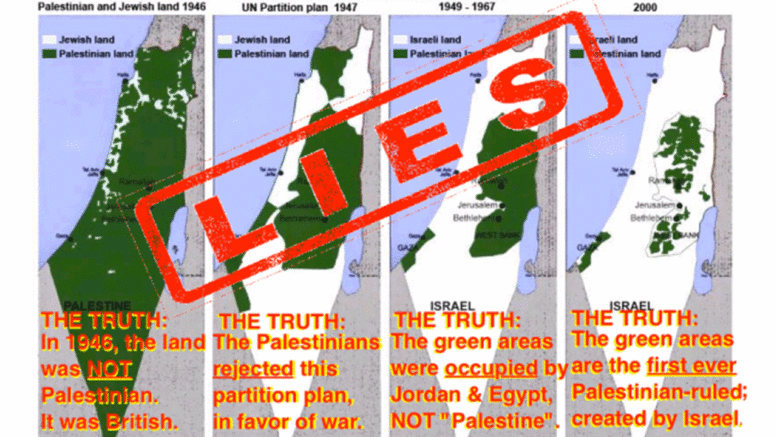The New Zealand Advertising Standards Authority appeals board has reaffirmed its original ruling that maps are just opinion. The historic and geographic facts are of no relevance to the industry watchdog. It seems content to undermine its own Code of Ethics and allow anyone to publish an advert, no matter how misleading or inaccurate, as long as they claim their image is the expression of a political perspective.
Last December, the “map of lies” billboard in Auckland was taken down after one day. The Advertising Standards Authority said “this is the best outcome we could hope for”, presumably because they, and the advertising company which removed the billboard, understood how misleading the maps were.
Since then, the billboard reappeared in the Auckland CBD. Unlike Ad-Vantage, Go Media refused to remove the billboard, saying they had been threatened with legal action from the Palestinian Human Rights Campaign (PHRC). The ASA has now ruled that the maps are ‘robust opinion’ and allowable because:
when it comes to strong political perspectives, there are no absolute truth or lies, just political standpoints”NZ Advertising Standards Authority decision 11/085
This statement will no doubt come as a shock to any serious cartographer.
An appeal was lodged, arguing that maps are actually representations of truth and there was nothing on the billboard to suggest that the cartography was intended as anything other than fact to support the accompanying “Stop the Occupation” rhetoric. The ASA Appeals board chairperson, Jenny Robson, agreed to re-hear the complaint.
The appeals board then ruled that
the maps were illustrative of a particular perspective and when the advertisement was considered in its entirety consumers would realise they were not [sic] presenting a political perspective from a group campaigning to stop the occupation of Palestine.”NZ Advertising Standards Authority Appeals Board decision 11/085
Save for what must be a typographical error, the ASA is essentially ruling that the “map of lies” does not mislead consumers because they are opinions.
It is hard to see how historical facts and geographic truths can be considered a political standpoint only. The ASA does acknowledge that there is a difference between opinion and fact; Rule 11 of the ASA Code of Ethics requires that “opinion should be clearly distinguishable from factual information”. Rule 2 of the ASA Code also makes it clear that advertisements cannot mislead:
Advertisements should not contain any statement or visual presentation or create an overall impression which directly or by implication, omission, ambiguity or exaggerated claim is misleading or deceptive, is likely to deceive or mislead the consumer, makes false and misleading representation, abuses the trust of the consumer or exploits his/her lack of experience or knowledge”ASA Code of Ethics [emphasis added]
The recent ASA and appeals board decisions make a mockery of the Code. There are a number of misleading impressions contained in the maps which have been debunked in many places. The ASA decision suggests that anyone can create an advertisement that is factually false or misleading as long as they claim it is a “political perspective” because that absolves all need for “absolute truths”.
The ASA decision is also out of step with international experience: MSNBC apologised for using the maps on air, Toronto Transport rejected the maps for use in their advertising spaces for being “inaccurate and misleading”, and McGraw Hill found the maps “did not meet our academic standards”.
These advertisers and academics can see how the maps conflate recognised territories with private ownership, how they manipulate the British Mandate of Palestine with the modern understanding of “Palestine”, and how the maps fail to distinguish between the areas totally controlled by Israel and jointly administered with the Palestinian Authority. We and many others have explained this before.
Even the PHRC wrote “[The billboard] merely sets out the Palestinian human rights movements beliefs … whether the billboard is right or wrong, the Palestinian human rights campaign organisation have the right to say it”. The ASA seem to agree, in defiance of their Code of Ethics which states that “no advertisement should be misleading or deceptive or likely to mislead or deceive the consumer” and “opinion should be clearly distinguishable from factual information”.
As we have already stated, despite the claim of PHRC, that “there is no consequence of the advertising”, such inaccuracy is dangerous. The intent of the maps is clear: to falsely demonstrate an “ethnic cleansing” that did not occur, one perpetrated by the “colonizer” Jews upon “indigenous” Arabs. This is history revisionism that throws kerosene on a fire and perpetuates lies that are used to delegitimize the State of Israel. Similar distortions have been correlated with anti-Semitic attacks on university campuses and as David Zwartz, of the New Zealand Jewish Council, has said
the New Zealand Jewish community regularly suffers increased backlash when there is public misrepresentation of the situation in Israel.”David Zwartz, New Zealand Jewish Council
The PHRC (led by Leslie and Marian Bravery), tried to suggest the ASA had no jurisdiction over the advertisement, writing:
I do not believe that the advertising appeals board has a mandate, the authority, is the correct venue, or has the required legal competencies or other background skills to deliberate, consider and decide upon such important social, historical, political, Bill of Rights, and freedom of expression issues”Palestinian Human Rights Campaign
The ASA and appeals board absolutely have the mandate and authority to adjudicate this matter. However, we might agree with the PHRC that, despite their biographies, the “legal competencies or other background skills” of the ASA members might not be up to scratch. In this instance, the ASA appeals board once again raises the question: if the ASA refuses to enforce its own rules, what is it there for?
We fully support free speech. However, the ASA is there to ensure reasonable limits on free speech. In this case, it has allowed an advertiser to dupe the public with false information that brings harm to a minority group in the name of pushing a political perspective. Would this be permitted for any other minority group in this country?
The ASA ruling suggests that if you have enough money to create a billboard and rent the space to show it, the ASA will allow it regardless of how deceptive it is as long as you call your imagery ‘robust opinion’ – or maybe the ASA will do that for you if they are sympathetic to the message, however misleading the content. Just be sure to use a map – they are apparently no longer matters of fact, but opinion. Next time you go to the library, don’t look for an atlas in the reference section. You will find it as political commentary, or more likely, in the fiction section.








